|

|
Number of versions: 16
Edition: March 1, 2013
|

With thanks to Raymond D.Ruitenbeek - NL for
his translations from the Hebrew.

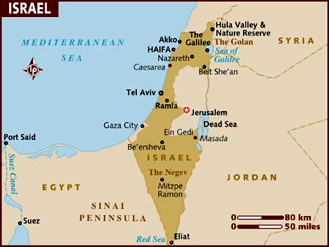 Except that a number of monopoly-like games are published by inland
manufacturers there are also official Parker
Brothers/Hasbro editions, manufactured by Kod
Kod/Lemada Light Industries
Ltd, owned by the Hertzano family, founded
in 1978. It is striking that Kod Kod, at
least during a number of years, used the Israeli banknotes design in
his editions and
issued 2 different versions of the gameboard:
Except that a number of monopoly-like games are published by inland
manufacturers there are also official Parker
Brothers/Hasbro editions, manufactured by Kod
Kod/Lemada Light Industries
Ltd, owned by the Hertzano family, founded
in 1978. It is striking that Kod Kod, at
least during a number of years, used the Israeli banknotes design in
his editions and
issued 2 different versions of the gameboard:
Issues till 1985:
From Hitchiel kan (Start here.Receive salary to the amount
of 200 passing by.) all properties are:
Arad: Rech Yehuda (Jehudastreet)
- Rech Ben Ya'ir (Ben Ya'irstreet)
Rakèvèt ha'amakim (Train of the valleys)
Kiryat Sj'mona: Rech Herzl (Herzlstreet)
- Rech Hayardén (Jordanstreet) - S'derot Tel Chai (Tel
Chaiboulevard)
B'toch hakèlè/Bikoer hakèlè (In Jail/On visit to Jail)
Teverya (T): Rech Blalik (Blalikstreet)
- Chevrat hachasjmal (Electricity Works) -
S'derot Herzl (Herzlboulevard) - Rech habanim (Sonsstreet)
Rakèvèt Másá BA"M (Freight trains Comp.)
Eilat: Rech Yotam (Jotamstreet) - S'derot
hat'marim (Palmslane) - Rech Ayalot (Hindsstreet)
Chani'ya chofsjiet (Free Parking)
Cheifa (Haifa): Derech
hayam (Seaway) - Rech Nordau (Nordaustreet) -
Derech ha'atsma'ut (Independenceway)
Rakèvèt tsafon (Train North)
Yerusjalayim (Jerusalem): Rech
Ben (Jaffastreet) - Rech Ben Yehuda (Ben
Jehudastreet) - Chevrat hamaim (Water Works)
- Rech Hamèlèch Dzordz (King Georgestreet)
Hikanés lakèlè! (Go to Jail)
Tel-Aviv: Rech Alenbi (Alenbystreet) -
Rech Gabirol (Ibn Gabirolstreet) - Rech Dizengoff (Dizengoffstreet)
Rakèvèt ekspres (Expresstrain)
Asjkelon: Park le'umi (National park) and Tayyelet (Boulevard
of Askelon)
Chance is here Hisdamnut (Opportunity)
and Community Chest is Sjerutei rewacha (Convenience
services).
Issues from 1985 onwards:
From Dèrèch tsléchá (Good luck! Each
lucky passer-by receives 200 New Sjekel) all properties are:
Eilat: S'derot hat'marim (Palmslane) - Rech Ayalot (Hindsstreet)
Rakèvèt haparbarim (Suburbstrain)
Teverya (Tiberias):
Rech hayardén (Jordanstreet) - Rech ha'atsma'ut (Independencestreet)
- Rech hagalil (Galileastreet)
Bét hakèlè/Ma'avar chofsji (Jail/Free passage)
Beér-Sjeva: S'derot
Sjazar (Sjazarlane) - Chevrat hachasjmal (Electricity
Works) -S'derot
Han'si'iem (Presidentslane) - Derech Eilat (Eilatway)
Rakèvèt Másá BA"M (Freight trains Comp.)
Natanya: S'derot Benyamin (Benjamin
Boulevard) - S'derot Weizmann (Weizmann Boulevard) -
Rech Herzl (Herzlstreet)
Chani'ya chofsjiet (Free Parking)
Ramat-Gan: Rech Aba Hillel (Aba
Hillelstreet) - Rech Dzjabotinski (Jabotinskystreet) -
Rech Bialik (Bialikstreet)
Rakèwèl Rosj hanikra (Cable-railway Rosj Hanikra = cable
car to the chalk rocks in the north of the country)
Yerusjalayim (Jerusalem):
Rech Yafo (Jaffastreet) - Rech Ben Yehuda (Ben
Jehudastreet) - Chevrat hamaim (Water Works)
-
Rech Hamèlèch Dzordz (King Georgestreet)
Lég lakèlè! (Go to Jail)
Cheifa (Haifa): Rech
ha'atsmaóet (Independencestreet) - Rech Hechaluts
(Pioniersstreet) - Rechov Moira (Moirastreet)
Rakèvèt tsafon (Train North)
Tel-Aviv:Rech Alenbi (Alenbystreet) - Rech Dizengoff (Dizengoffstreet)
Chance is here Haftá'ah (Surprise)
and Community Chest is Tibat hamazal (Fortune Chest).
 Edition:
Judaica Monopol
(= Jewish Monopoly)
Edition:
Judaica Monopol
(= Jewish Monopoly)
Children Monopoly Game
Publisher: Inland company Amarna (?) - ±1960
Dimensions of the box: 39 x 24 x
3.5 cm
The game:
This edition is from the collection of
Harold Lee
- UK.
The illustrations on the lid are apparently.on purpose childlike, because it is
said this game to be"for children".
 As
Harold bought his set some time ago it was estimated from its design to be from
about 1948 but in February 2013 he found it offered on ebay showing this tax
label. It is said these labels have only been applied in the sixtees of last
century, meaning the set to be some 12 years younger than originally thought.
As
Harold bought his set some time ago it was estimated from its design to be from
about 1948 but in February 2013 he found it offered on ebay showing this tax
label. It is said these labels have only been applied in the sixtees of last
century, meaning the set to be some 12 years younger than originally thought.
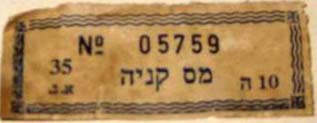
has this label number with 05759 in the box.
It could indeed be possible these labels have something to do with tax
control. On the other hand if it is an indication for the time it was applied, it still is interesting to know the real function of the tag
The design of this bilingual edition apparently is the most ancient of
all editions in this chapter. Since it is known that
Israel proclaimed its
independence on May 14, 1948,
this edition from about
1960 probably is the1st
Monopoly game ever
made in Israel is.
Of this game are so far only 2 copies known.
Although no Parker,
nor Waddingtons copyright
is mentioned, it is clear that
the authors of this
game must have been aware of the Parker Monopoly
games, because the
division of the properties on the
board is the same, although
with different color
bars for the properties
and different pictures on the
corner squares.
The design of the board,
showing pictures on
top the streets,
reminds of the early Austrian DKT
editions, see http://www.muurkrant.nl/monopoly/a_-_standard_editions.htm.
These are probably the only
two countries with
such a design.
From Bon Voyage all spaces are:
Ashkelon: Johannesburg Street - Cashier's
order - Drom Africa Blvd. - Income Tax
Bus line Tel Aviv - Jerusalem
Tiberias: Rabbi Meir Street - Surprise -
Nazareth Street - Hagalil Street
Passage
Beer Sheba: K.K.L. Street - Electric Company
- Palmach Street - Azmouth Street
Bus line Tel Aviv - Haifa
Nataniah: Benjamin Blvd. - Cashier's order
- Weizmann Blvd. - Smilanski Street
Parking
Ramat Gan: Jahalom Street - Surprise -
Modiin Street - Bialik Street
Bus line Tel Aviv - Beer Sheba
Jerusalem:
Jaffa Road - King George Avenue - Water Company - Ben Yehuda Street
Sentence: Go to prison!
Haifa: Hehalutz Street - Nordau Street - Cashier's
order - Haral Street
Bus line Tel Aviv - Tiberias
Tel Aviv: Dizengoff Road - Purchase Tax
- Allenby Road.
The title deeds (81 x25 mm) are on thin stiff card with plain brown
backs.
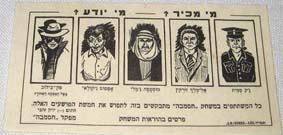 The
Surpise (Chance) cards (84x 50 mm) are numbered 1 to 16, printed in black on
pale sage
green very thin cards
The
Surpise (Chance) cards (84x 50 mm) are numbered 1 to 16, printed in black on
pale sage
green very thin cards
with
plain backs. The Cashier's Order (kind ofCommunity Chest) cards are also
numbered 1 to 16., on
yellow buff. cards,
otherwise identical to Surprise cards.
The money consists of 7 banknotes of very thin white paper (80 x38
mm), 20 of each
(except 100 unit x 21):
1 - 5 -10 -
20 - 50
-100 and 500.
The houses (17x14 mm) are made of thin flat translucent plastic, without chimneys.
The hotels (20x19 mm) are
also made of thin flat translucent plastic, but with
chimneys.
The Rules booklet (23.8x16.8 cm) has 4 pages in
English and other 4 in Hebrew. It says the game is for but 4
players, but there is however a card showing 5 strange figures and because the
text is in Hebrew only it is not clear
what this card is saying. The name Amarna (what possibly can be the
manufacturer) is only mentioned on this booklet.
The 4 tokens are translucent plastic pawns in red, pale blue, green and yellow.
The 2 dice (14 mm) are of opaque white
plastic with red pips.
This
set was offered for USD 89.- on ebay, February 2013.
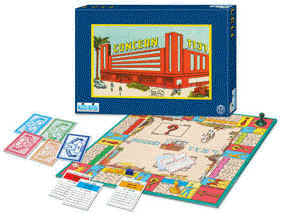 Edition:
Rikuz - Concern
Edition:
Rikuz - Concern
Publisher: Kod Kod - Tel Aviv - ±1950/1999
Dimensions of the box: ±50 x 40 cm
The game:
Micha Hertzano knows to tell the story of this typical Israelian
game:
"Rikuz - game has been introduced in the Early Fifties of the
20th century by a company in Israel called: 'Bar Levy '.
At the time there was no Monopoly available in Israel.
It has been reproduced in 1999 by Kod Kod in a limited edition for the
Eretz
Israel Museum, showing old/antique games and other products from the days of the establishment of
Israel in one of their pavilions. With the consent of the wife of late Mr. Bar Levy and Mr. Tarkatover - curator of this
exhibition it has been produced as a 1:1 replica of the old game in old fashion design and without
any changes.
It is not available on the market any more."
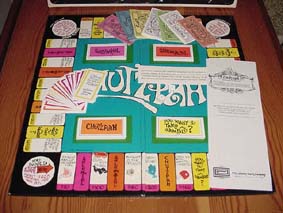 Edition: Chutzpah
(The Game of the Good Life)
Edition: Chutzpah
(The Game of the Good Life)
Publisher: What-cha-ma-call-it, Inc./The Middle Earth
Comp./CADACO - 1967
Dimensions of the box: unknown.
The game:
(Have you noticed the names of the designer and manufacturer?)
This game was offered on the internet auction site ebay
in July 2000. Because this is also a game in which players have to gain as many
properties as possible by acquiring them with money, while the game is
influenced by (in this case 4 different) cards, I consider it as a monopoly-like
game and as such worth to mention it in this catalogue. Seller of this game
said:
"Object of the game: When you get married, you
start up the road to the good life. You begin with a kniple of wedding
presents, and try to get more gelt, and acquire possessions. If a player
has mazel, and chutzpah, and a rich Father-in-law, his gelt and
possessions will increase. If he has shlemiel or shlemazel, he'll
have nothing but tsoris!"
Some of the plastic tokens are: denture - hot dog and a little poodle.
The currency of the banknotes is $.
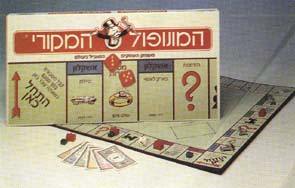 Edition:
Standard - with red bar, ref. 300
Edition:
Standard - with red bar, ref. 300
Publisher: Parker Bros./Hasbro - Kod Kod - 1985
Dimensions of the box: 25.5 x 51 cm
The game:
This is the Israelian version of the original Parker Bros. game, i.e. a box with
the red bar and both 2 blue streets on the cover. The board is of
strong cardboard.
The money consists of the 7 Monopoly banknotes, so with the house and locomotive.
The tokens are the
well-known metal figures: car - dog - boat - shoe - hat - iron - thimble and
wheelbarrow "made in Hong Kong". The green
houses
and rode hotels
are made of plastic, having a roof with a chimney and very large tiles as well
as profiled façades.
The language used is Hebrew only.
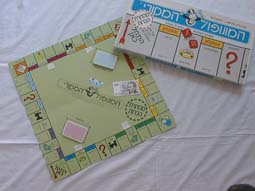 Edition:
Standard - with blue bar, ref. 300/1
Edition:
Standard - with blue bar, ref. 300/1
Publisher: Parker Bros./Hasbro - Kod Kod - 1985
Dimensions of the box: 25.5 x 51 cm
The game:
The difference with the former version is that the red
bar on the cover
of the box is replaced by a blue one. It is strange that the
blue street
on the cover is yellow.
The bottom of the
box shows a black/white picture of the game board with on top the box,
houses and hotels and two white dice, whereas those on the lid are red
with gold pips. Out of the game board are some property cards and Monopoly
banknotes. So this must be a picture of the earlier mentioned version with red
bar.
On the lid and in the corner of the game board next to Jail is an
interrupted red circle with the words "Mahadrut
hèkarut"
(Aquaintance edition).The game board (with white
back) is of soft cardboard and the attributes are loose in the box. This is
obviously a cheaper edition. Although this is an official Parker Brothers
issue the money is a game version of the real Israelian banknotes (dim.
55 x 95 mm) with portraits of statesmen, in the denominations: 1 - 5
- 10 - 20
- 50 - 100
and 500. The Chance
and Community Chest cards are with those funny drawings of Uncle
Pennybags.
The 8 tokens are simple plastic pawns now.
The dice are black
with white pips.
This edition is "Made in Israel".
Edition: Inland Monopoly 1
Publisher: Inland publisher - ±1990
Dimensions of the box: 37 x 24 cm
The game:
This version differs considerably from the usual idea of the Parker Brothers
Monopoly games.
The 3 corners of the gameboard show a bridge, a power
station and a circus tent. At the place of the stations are
respectively an aeroplane, bus, boat and a car. Also the
colours of the streets differ.
The money consists of copies of the real banknotes with the portraits
of statesmen as well. On one stack of cards in the centerfield is a
"?" and a "flying deer", the Israelian Post's logo, on the other. The red
houses and blue hotels are flat
discs.
The price amounted to NlS 45.- (€ 11.35) in April 1995.
Edition: Inland Monopoly 2
Publisher: Yeda Games - Tel-Aviv - ±1990
Dimensions of the box: 50 x 23 x 5 cm
The game:
This is a unique edition. The board is divided into 3 parts. The 2 stacks
of "Chance cards" have to be placed on the left part. The pointer
next to it must be turned over the disc the moment a player enters one
of the relevant fields. The pointer indicates from which stack a card has to be
taken.
The streets of each city build one picture together. On top of
each field are 4 plots meant for each of the 4 colored houses. Instead of 4
stations there are but 2 airports.
The price amounted to NlS 45.- (€ 11.35) in April 1995.
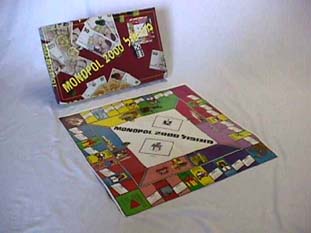 Edition:
Monopol 2000
Edition:
Monopol 2000
Publisher: Inland publisher - ±1990
Dimensions of the box: 25 x 39cm
of the board: 46.5 x 46.5 cm
The game:
(This edition is available in three different boxes.)
The soft gameboard indeed shows Monopol in large characters , but
it considerably deviates from the standard board. Start is called Bon Voyage
and the stations are Taxy (!) stations. The title cards that go with
these stations are oblong like those of the game of ref. 2002.
The city and street names are in 2 languages in a white band over a plain
colored field. The town that occurs only in this issue is Safed. Is this perhaps the hometown of the maker of this
game?
The cities and streets are from Bon Voyage onwards:
 |
Safed: Jerusalem Street - Ha’ari
Street |
 |
Tiberias: Rabbi Meir Street - Yehuda
Halevy St. - Hagalil Street |
 |
Jeruzalem: Jaffa Road - King George
Ave - Ben Yehuda St. |
 |
Netaniah: Benjamin Blvd. - Weizmann
Blvd. - Smilanski Street |
 |
Haifa: Hahalutz Street - Norday Street
- Herzl Street |
 |
Eilat: Los-Angeles St. - Yoseftal
Street - Eylot Street |
 |
Ashkelon: Johannesburg St. - Drom
Africa Blvd. - Herzl Street |
 |
Tel Aviv: Allenby Road - Dizengof Road |
The small banknotes (dim. 40 x 70 mm) are as always, copies of the
real banknotes with portraits of statesmen. The 6 denominations in
NS, are resp.: 1 -
5
- 10 - 20
- 50 and 100. They
have however, like the property deeds, Surprise-and Cashier's Order
cards, to be released from sheets before they can be uesed. (The "Cashier"
is a gruffy looking, long haired young lady with eye-shade and tie!)
The hollow green houses and red
hotels are of plastic. They have no roof rim but do have a
visible foundation. The 4 tokens are those of "Aggravation".
The white dice with black pips are very small.
The instructions are in English as well.
The price amounted to NlS 45.- (€ 11.35) each in April 1995.
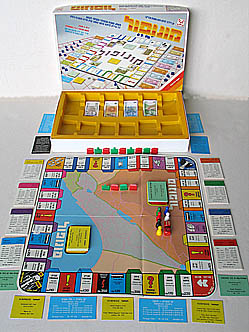 Edition:
Monopol - with map of Israel on the board, No.2002
Edition:
Monopol - with map of Israel on the board, No.2002
Publisher: Creative Toys Ltd. - ±1990
Dimensions of the box: 23 x 46 cm
of the bord: 39.4 x 39.4 cm
The game:
The lid of the box shows a different (white) board from that inside the
box. The
shown banknotes also differ from that inside the box! The lid suggest blue
houses
and hotels, whereas the game has to be played with 16 red
and 16 green houses
and 8 red and 8 green
hotels. These houses and hotels are flat and therefore have a base. The midfield of the soft
cardboard
gameboard with round corners shows a map of Israel. In the innerbox is a
yellow plastic insert with 12 trays for the banknotes etc..
From Go On onwards the 8 cities are respectively:
 |
Haifa: Herzl Street -
Habankim Street - Hazmauth Street |
 |
Tiberias: Hagalil Street - Golani
Street |
 |
Nataniah: Weizman Blvd - King David
Street - Raziel Street (on the board: only in Hebrew) |
 |
Tel-Aviv: Dizengoff Street - Alenbi
Street - Arlozorov Street |
 |
Ramt-Gan: Bialik Street - Herzel
Street - Negba Street |
 |
Jerusalem: Ben-Yehuda Street - Jaffa
Street - Haneviem Street |
 |
Beer-Sheba: Hanadiv Street -
Haestadrut Street - Sinai Street |
 |
Eilat: Hadekel Street - Hatmarim Blvd. |
The 4 stations, which are only on 3 sides,
are of the bus lines: Hifa-Tiberias - Nataniah-Tel-Aviv - Tel-Aviv-Jerusalem
and Beer-Sheba-Eilat. The busses busses always maintain the service between the
cities of the 2 adjacent fields. The matching title cards deviate from those of
the streets. These 4 cards are blue and their dimensions are 45 x 90 mm.
The 3 corners successively show: Free Passing/Prison
- Parking and Cuort (or better: court?), where a judge is shown
sentensing: Go to prison.
The 17
yellow cards (dim.: 45 x 60 mm) are called Surprise, whereas the 17 numbered green
cards are the Order cards. The money
is again that with portraits of statesmen, however in the smaller size
of 40 x 70 mm. The only 5
denominations are: 1 - 5
- 10- 50
and a lot of 100.
The tokens
are 4 plastic "Aggrivation pawns". Both wooden dice are red
with gold pips.
The game is bilingual, the instructions however aren't.
Edition: Junior standard - Hebrew, ref. ?
Publisher: Parker Brothers - Kod Kod -±1992
Dimensions of the box: 51 x 25.5 cm
The game:
It was in 1991 the first issues of Junior Monopoly sets came on the
market, so 56 years after the game "for players from 8 years on" was
issued. This game is for children from the age of 5.
Just like in the regular Monopoly game the aim is to collect as much money as
possible. The moment one of the players runs out of money the other players
must count up their money to see who won the game.
The game board is slightly larger than that of the other Junior
editions.
The money consists of colored notes printed in black with Rich
Uncle Pennybags in various different situations. The 5 denominations are resp. 1
- 2 - 3
- 4 and 5.
Four children can play at the same time, because there are 4 pyramid shaped
tokens,
respectively yellow, red,
blue and green.
The ticket booths are to be distributed amongst the players with the same
color of car.
The game "takes place in a children's favourite univers: a splendid fun
fair" and will be over in about 20 minutes. Uncle Pennybags brings you to
the roller coaster, magic show, water chute, dodgems, puppet show, miniature
golf, a.s.o.
In the coarse of the game ticket booths can be bought to place on
an Amusement so that it becomes your property. If you also own the other
Amusement of the same color, one must pay double the amount shown on the space. There are 6 Chance- spaces where cards can be drawn with instructions
like "Go to the water chute" and
"Pay 3.- to take the tram to the cafe".
The dimensions of the tickets are: 55 x 84 mm.
The price amounted to NlS 53.- (€13.16) in April 1995.
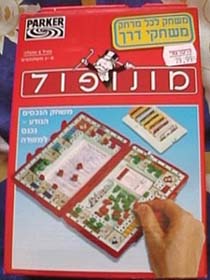 Edition: Travel edition, ref. 14248
Edition: Travel edition, ref. 14248
Publisher: Parker/Tonka/Hasbro - Kod Kod - 1994
Dimensions of the case: 5 x 12 x 18 cm
The game:
The red outer box clearly shows a picture of
the inside of this red case.
This variant is a well-refected and practical travelling companion indeed. The tokens
can be fixed on each space but not more than just one. That means that the next
player landing on the same street has to move one step further. Only on the
corners is sufficient space for 4 players to stay. There are also 4 holes per
street for the houses and hotels.
There are no Chance- nor Community Chest cards. Instead three dice
have to be thrown and the instruction mentioned in the table with the
corresponding number to be carried out.
For the rest the rules remain the same
as of the standard game.
Instead of a free ticket to leave Jail you get one of the 6 keys.
These red cases are made in China.
Suitable for children from 8 years on.
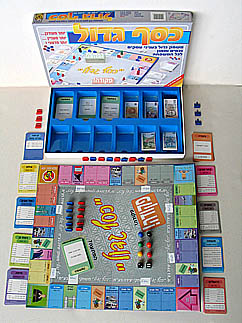 Edition:
Big Money, ref.5094
Edition:
Big Money, ref.5094
Publisher: Creative Toys Ltd./Mischakee Yetsira - ±1995
Dimensions of the box: 24 x 41 cm
of the board: 40 x 45.5 cm
The game:
The lid of the nice looking strong box shows all items of the game clear and
true. (This unlike the former mentioned game of the same publisher.) The inner box
has a blue plastic insert with 12
trays for the banknotes and the other attributes. The board is strong
and heavy and has a dark blue back.
The cities of this edition are exactly the same as those of the one
with the map and, with a few execptions, the streets as well.
However the order is from Go On onwards:
 |
Tel-Aviv: Ben Yehuda Str. - Ibn Gvirol
Str. - Dizengoff Str. |
 |
Tiberias: Hagalil Str. - Golani Str. |
 |
Eilat: Hadekel Str. - Hatmarim Blvd. |
 |
Jerusalem: Hanevi'im Str. - Jaffa Str.
- Ben-Yehuda Str. |
 |
Beer-Sheba: Sinai Str. - Hanadiv Str. -
Hahistadrut Str. |
 |
Netanya: Hamelech David Str. -
Weizman Blvd. - Raziel Str. |
 |
Ramt-Gan: Herzl Str. - Bialik
Str. - Negba Str. |
 |
Haifa: Ha'atzmaut Str. - Herzl Str. -
Habankim Str. |
The 4 stations, now again one on each
side, are of the bus lines: Tel-Aviv-Jerusalem - Netaniah-Tel-Aviv
- Tiberias-Haifa and Beer-Sheba-Eilat. The busses no longer
maintain the service between the 2 adjecent cities of the space.
On the 3 corners are respectively: the Court, Stop for a refreshment
and Jail. Especially the first and last one have remarkably been
exchanged compared to the edition with the map. The Title Deed cards and the Surprise-
and Order cards have nicer been edited than those of the other games. There are 21
Order cards and as many
as 52 Surprise cards.
The money consists again of the tiny banknotes with portraits of statesmen, however in the smaller size
of 40 x 70 mm. The only 5
denominations are: 1 - 5
- 10- 50
and a lot of 100 again. Meanwhile this is no longer a true reflection of
reality because the banknotes of 1 - 5 and 10 Shekel became coins.
The flat houses and hotels are red and
blue. The 6 tokens are plastic
cylinders-with-ball.
Both dice are black with white pips.
This edition is not bi-lingual.
The price of this game amounted to NlS 69.90 (€19.03) in October 1997.
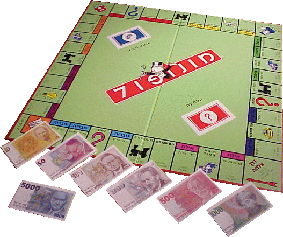 Version:
Standard, ref. 06951256
Version:
Standard, ref. 06951256
Publisher: Parker Bros./Tonka - Kod Kod - 1995
Dimensions of the box: 26 x 51 cm
The game:
This is an issue from the Irish works, so on the lid again a picture of the
fourth side of the gameboard with the "collected
attributes" on a green
background.
The back of the gameboard is red,
like the plastic insert of the innerbox. Sloping over the light green
midfield is the red bar with Monopoly in
white characters and Uncle Pennybags coming out the mid O.
At the bottom of the box is the well-known color-picture-of the-laughing-family, looking to eachother rather than to the
game.
The Chance cards have a red back with
a ? and the Community Chest cards are printed blue with
the well-known treasure chest in a circle. The banknotes are not like in
most other countries Monopoly money but still the very own notes with the portraits of statesmen. However...
everything became more expensive.That is why you now receive 2000 Shekel at Start
and the t denominations became: 10 - 50
- 100 - 200
- 500 -1000 and
5000.
The 10 tokens of heavy metal ("made in China") are resp.: hat -
wheel-barrow - shoe - car - kanon - rider-on-horse - thimble - iron - boat and dog.
The green plastic houses do have a
chimney, the red hotels haven't. Both
dice are white with black pips.
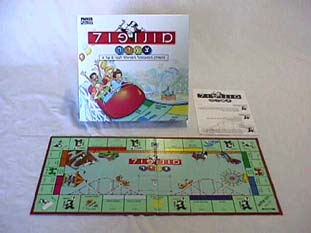 Edition:
Junior standard - Hebrew, ref.14540256
Edition:
Junior standard - Hebrew, ref.14540256
Publisher: Parker/Tonka/Hasbro - Kod Kod -1996
Dimensions of the box: 26.8 x 26.8 cm
of the board: 25 x 50.5 cm
The game:
The differences between this version and former issues are:
 |
A total new and square box. |
 |
A new picture on the cover: Children in a car of the roller
coaster with 2
springing dolfins at the background. |
 |
The colour picture at the back of the box shows a (new)
picture of 3 kids
playing on an English board. The
banknotes they use do not belong to this game. |
 |
The back side of the board is red, as the tray insert of the inner box is. |
 |
The tokens are colored plastic cars. |
 |
The Chance cards became much smaller: 43 x 63 cm. |
The price amounted to NlS 92.- (€ 24.96) in October 1997.
 Edition:
Standard, ref.14535256
Edition:
Standard, ref.14535256
Publisher: Parker/Hasbro - Kod Kod - 1997
Dimensions of the box: 26.8 x 40.3 x 5.3 cm
The game:
This edition is a sample of the new standard presentation from Hasbro: a fresh
white box with red bar and a part of
the fourth side of the board on the lid. The new dimensions are such that the game
board (with red back) had to be folded
twice. So herewith the long box we called standard so far disappears.
Also this issue is manufactured in Ireland.
The color picture on the bottom of the box is the one of the laughing to
eachother family that forget to play. The game board they are using is not the
Israelian one.
The red plastic insert in the innerbox
has many trays again for as well the money as the houses and hotels and the
property deeds and so serves as banker's tray.
The banknotes are now again of Monopoly, issue1996 Tonka Corporation, as
well in the original lower values. The
7 denominations are resp.: 1 - 5
- 10 - 20 -
50 - 100
and 500. At Start one
receives 200 Shekel, like in the earlier editions. The10 metal tokens
are car - boat - hat - iron - canon - rider-on-horse - thimble - dog -
wheel-barrow and shoe.The green houses
with overhanging roof do have a chimney, the red hotels don't.
Both dice are white with black pips.
The price of this game amounted to NlS 108.- (€ 29.50) in October 1997.
SELF - MADE GAMES
The
first handmade game I coaght sight of is a very special one, behind which is so
much unspoken history and immense sorrow that it is impossible for me to
describe it here. It was made in WW II in the ghetto of Theresienstadt in
the Czech Republic.
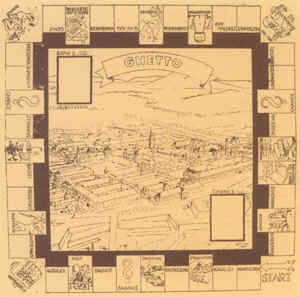 Version:
Ghetto - 1943
Version:
Ghetto - 1943
Property of: camp inhabitants Micha and Dan Glass - Israel
Dimensions of the game board: ~ 50 x 50 cm
The game:
In the period between October 2000 and December 2001 the travelling exhibition
"No child's play"
was shown in 6 Dutch museums. It was arranged by "Yad Vashem The Holocaust Martyrs' and Heroes' Remembrance
Authority" in Israel.
Thanks
to the assistance of Mrs.Yehudit Inbar (Yad Vashem -
Israel) and the management
of the Theo Swagemakers museum in Haarlem (http://www.swagemakersmuseum.nl)
I am able to give some comments to this game:
This could be read
in the museums:
"Theresienstadt (the present Terezin, as small town between Dresden
and Prague)
was a special ghetto that was started in the Czech Republic in November 1941 in
a fortress from the 18th century. There Jews from the Czech Rep., Germany,
Austria, Holland and Denmark were deported to. In fact the ghetto was an
intermediate station for Jews on their way to the death camps. The
Germans had interest in . Among the inhabitants of the ghetto were
painters, composers, musicians, writers and many scientists. Despite
overpopulation, starvation and diseases comprehensive education and cultural
activities took place."
Mrs. Inbar tells:
"It was brought to Israel by Micha and Dan Glass. We assume it was made for
the children secretly in one of the printing sections of the ghetto. My thoughts are that it served a
number of purposes:
1. As a regular Monopoly game.
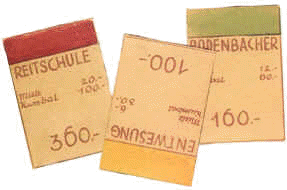 2.
It could be colored in - there is another game, like it but colored,
2.
It could be colored in - there is another game, like it but colored,
in Beit Terezin Museum in Givat Haim in Israel. (This
version
was shown in the Netherlands.)
3. It taught the children the layout of the ghetto (it was forbidden
to wander around in the Ghetto particularly for the chidren who
lived separately from their parents, for instance they could see
where their parents lived in relation to where they themselves
lived.)
4. In addition through the game they could learn about the different
places that
it was important they familiarize themselves with - the
bakery, the prison ..."
The fields are from Start onwards:
Hohenelber
- Kavalier - Produktion - Entwesung
- Spedition - Chance - Bauhof - Post
- Aussiger - Gefängnis - Kaffehaus
- Elektr.W. - Freizeitgest. - Bastei
- Küche - Zeughaus - Chance - Bodenbacher - Dresdner
- Dekade - Genie - Bank d. Jüd. Selbstverw.
- Hamburger - G.W.-Kas
- Fleischer - Judenheim - Wasserwerk
- Zentralbad - Reitschule
- Geh' ins Gefängnis - Bäckerei - Landwirtsch.
- Chance - Jäger Kas. - Proviantur - Bank d. Jüd. Selbstverw.
- Hannover - Schleuse and Magdeburg.
Many
texts of the Chance- and Bank cards are (almost) identical to
those of the regular game, however there are that are strongly referring to the
ghetto life. Some texts read:
 | Als Bankdividende erhältst Du 50,-. (As
bankdividend you receive 50,-.) |
 | Geh in die Hamburger, bei Startübergang erhältst
Du 200,-. (Go to Hamburger. If you pass Start you receive 200,-.) |
 | Die Produktion zahlt Dir 25,-. (Production pays you 25.-.) |
 | Strafe wegen Ruhestörung 16,-. (Fine because of disturbance of the peace 16.-.) |
 | Wegen Übertretung d. Ghetto-Gesetze Strafe:
10,-. (Fine because of infringement of the Ghetto
rules: 10.-.) |
 | Erhöhung Deiner Arbeitsqualifikations. Du erhältst
45,-. (Increase of your working qualifications. You get 45.-.) |
One of the Bank d. Jüd. Selbstverw. spaces show two banknotes
with the currency in ... Kronen, because the camp-money
was in "Th. kronen".
It is striking that no purchase values are shown on the spaces of the game
board. These are only on the property deeds, on which however neighter the
mortgage values are mentioned.